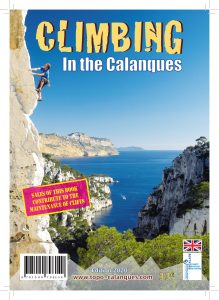
The Calanques climbing guidebook (new English version)
We spent so many years working on this collection of information, tracking the original routes… so many months climbing up the numerous trad or bolted routes…
This guidebook is a large selection of climbing routes in the Calanques. It is the continuation of the previous guidebooks published by the CT13 FFME. We tried hard to meet several criteria: publish a guidebook in a single volume, provide a description of the Calanques that is as thorough as possible, meet climbers’ expectations and preferences, and arouse interest in all types of climbing. That is why we chose to present several new areas that were not described in previous guidebooks. This guidebook is not exhaustive when compared with a collection of 10 complete guidebooks that were published a while ago by Alexis Lucchesi.
We cannot claim to be exhaustive because anyone can find traces of climbing or equipment on any cliff, even unexpected ones. Climbers are more modest than we can imagine, and some climbers who discover new routes do not feel the need to shout it from the rooftops! For the topographer, the collection and verification of information is a real vocation. We could never thank our twenty or so diligent collaborators enough. Some helped the editorial team, while others provided us with information, comments, criticism,
pictures etc.
During our research, we noticed that our work created many expectations but also, sometimes, concern.
Hopefully we managed to fulfil these expectations. Moreover we would like to reassure people concerned about the consequences of this guidebook on the affluence of tourists. Nowadays climbers can choose from a wide range of guidebooks about the Calanques, in French and various foreign languages. There are also many websites dedicated to climbing in the Calanques. This area has growing international reputation over the past decade. The creation of the Calanques National Park has also contributed to public awareness of this
area. We would be honoured if this modest book could in some way influence the future of the Calanques. We also wondered whether there would be sufficient demand for a book, because social networks already provide access to detailed information about almost any climbing crag. We won’t solve the dispute between books and the internet here, but we think that both are complementary, and are not competitive. Moreover, a paper guidebook establishes an essential database that can be used by rescue teams in the case of an accident. Finally, libraries are the most reliable places to keep a record of this intangible climbing heritage.
In conclusion, we would like to remind climbers that our sport is a marvellous natural activity, but it also involves risks and hazards that should not be underestimated. Each climber should be careful, respectful and use careful judgement in evaluating these risks while climbing. Only then can you fully enjoy all the wonderful moments spent between the sky and the earth or the sky and the sea.
